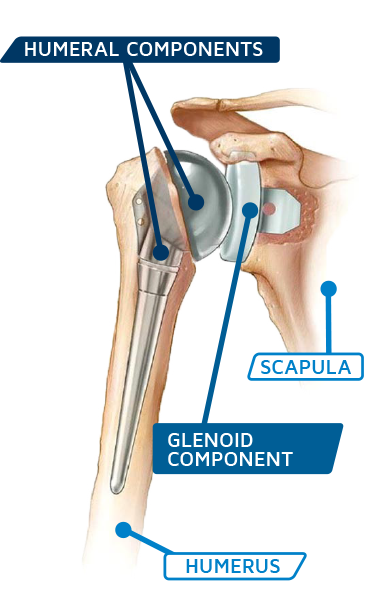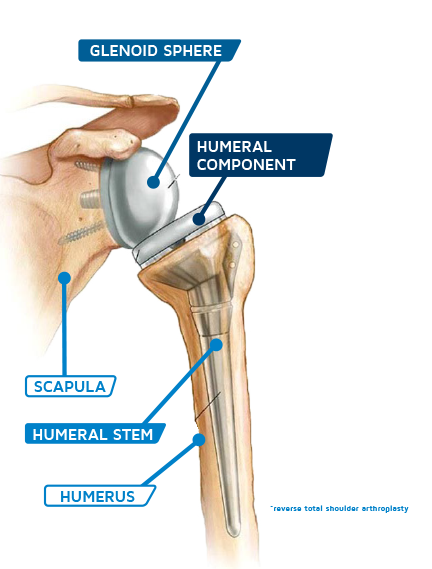Total Shoulder Replacement Services
Indications
The primary indication for a total shoulder arthroplasty (TSA) is when severe shoulder arthritis is limiting the quality of the patient’s life and has not improved with conservative treatments. Shoulder joint arthritis may limit your ability to perform self-cares, household duties, driving, and other functional activities. The recovery for a patient following a TSA surgical procedure will vary in length and aggressiveness depending on factors such as:
- Degree of arthritis
- Acute versus chronic condition
- Length of time immobilized
- Strength/pain/swelling/ROM status
- Rehabilitation goals and expectations
Total Shoulder Arthroplasty Surgery
 A shoulder replacement consists of two parts:
A shoulder replacement consists of two parts:
1. The humeral (the ball) component, which is made of metal. This is fixed to the arm by a stem that fits into the shaft of the bone.
2. The glenoid component (the socket) is made of a high-dense plastic material.
During the surgery, the surgeon will remove the damaged cartilage and replace with the above mentioned components. Every procedure is different, but they generally take up to 1-2 hours to complete. The incision for the TSA is approximately 4-6 inches long and is often in the front portion of the shoulder. There may be sutures/staples to remove at your follow-up appointment.
 Total vs. Reverse Total Shoulder Arthroplasty
Total vs. Reverse Total Shoulder Arthroplasty
A standard TSA replicates the normal mechanics of the shoulder, replacing the ball and socket as they are normally found in the human body. A TSA also preserves a patient’s rotator cuff muscles. A reverse TSA “switches,” or reverses the ball and socket placement. The reverse TSA is usually indicated when a patient has poor integrity of the rotator cuff muscles or has had multiple failed rotator cuff repairs, along with shoulder arthritis.
Recovery
The recovery process after a total shoulder replacement varies depending on your previous level of activity, how your body responds to surgery, and your level of activity after surgery. Often, after a total shoulder replacement, you are referred to physical therapy that is done either in your home, if you have difficulty leaving your home, or in an outpatient clinic. Based on your evaluation, the therapist will develop exercises and other treatments to help you reach your goals of increased function and decreased pain.
Common and normal recovery signs include bruising around the shoulder, upper arm and even into the chest. Bruising can look deep and dark. It might also look yellow or green in color. This bruising can develop as late as 3-5 days after surgery and will resolve with time.






